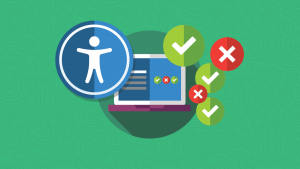May 19, 2022
Inside and Out: Working with Vendors to Improve Accessibility
Co-authored by the UW Libraries Accessibility Working Group
Digital resources and services have become an integral part of library functions. While this increases access for many, it can present new barriers for some users with disabilities. To recognize Global Accessibility Awareness Day, we’re sharing more about accessibility audits to help increase digital access and inclusion at the UW Libraries and Press.
Projects involving accessibility audits are becoming increasingly common at the UW Libraries and University Press and help ensure we’re providing our core services in an equitable way.
“Libraries are all about providing access to information – and that’s physical access and electronic access,” said Collection Assessment Librarian Hana Levay, who helped evaluate if Libraries users could retrieve results using only their keyboards. The keyboard navigation project tested roughly 650 library products. Afterward, the team reached out to vendors of products that failed to talk about possible improvements and shared their results publicly so others can use the information in their own purchasing decisions.
Accessibility audits are a process to evaluate the usability of technologies for people with disabilities. They involve performing tests to make sure people with visual, hearing, motor, or cognitive disabilities can use web-based resources and services to the fullest, and can help inform prospective clients as to whether or not they should invest in certain products.
“…introducing a new technology without first vetting it for accessibility results in late, impartial and inequitable services”
Implementing these audits before a new technology is adopted helps organizations understand, improve, and plan accommodations for the products that will ensure all users can take advantage of it – rather than scrambling to accommodate disabled users after the fact or leaving the work of ensuring access entirely to the office of Disability Resources for Students.
“Accessibility is becoming the responsibility of those people who are selecting and implementing a new technology to campus,” said Hadi Rangin, IT Accessibility Specialist for Accessible Technology Services. He says when universities introduce a new technology without first vetting it for accessibility, it results in late, impartial and inequitable services for disabled members of our community.
Rangin works with other members of the accessibility team to perform audits of various technologies used at UW, including a number of software products offered by the Libraries. This process includes assessing resources to identify any problems and barriers the user may encounter, and then working with vendors to create a roadmap for improving. Manifold and Pressbooks, two digital book publishing platforms, are examples of resources that have received accessibility audits.
Other initiatives include work at the University Press to create more accessible ebooks for people who use assistive technologies and an effort to collect and assess Voluntary Product Accessibility Templates (VPATs) from library vendors before resources are adopted or renewed. This brings accessibility into the procurement process. These self-disclosed documents describe how the vendors feel they do or do not meet accessibility standards. New methods for assessing VPATs for accuracy and completeness can help with ranking vendors by their accessibility efforts, which brings more attention to those areas most in need of improvement. VPAT assessment gives the Libraries a starting point to have conversations with these vendors about the accessibility of their products and possible improvements.
“I think it’s really important for us as librarians to hold companies accountable for making accessible or more accessible products”
Beyond ensuring we’re serving the entire UW community more effectively, testing products and discussing possible improvements also helps other organizations become more accessible. Many of these audits have included working directly with vendors to identify problems and improve the accessibility of their software. Others have included sharing results publicly, so people considering adopting certain products have more robust information to work with before they decide.
“I think it’s really important for us as librarians to hold companies accountable for making accessible or more accessible products,” said Open Education Librarian Lauren Ray.
That said, the work can present challenges. Often it’s taken on by small or under-resourced groups who aren’t sure where to turn for training or support. In many cases the people initiating the work don’t identify as disabled themselves. And while some vendors and technology companies welcome the opportunity to make their products more accessible, others resist change. Even when they are receptive, the solutions can be complex and costly.
The reality is accessibility work is an ongoing process. “As long as you can test, it continues. I don’t think there’s anything that’s perfectly accessible,” said English Studies and Research Commons Librarian Elliott Stevens. “There will always be a new update to assess, a bug to fix, or an improvement to be made. “This is a long term project. It’s something that we’re going to be working on all the time,” said Collection Strategy and Licensing Librarian Faye Christenberry. “I don’t imagine it’s ever going to be 100% done. It’s about going back and continuing to push for improvement.”
That in and of itself can feel like a barrier – but it’s not insurmountable. “When we started thinking about this it just seemed absolutely overwhelming,” said Beth Fuget, who works with grants and digital projects at the UW Press. “It’s actually not as huge a challenge as it seems in order to get started.”
For those looking for a place to begin, one place to start is seeing if your organization offers training, support, or expertise to vet products and services for accessibility. Rangin also recommends including the expectation of accessibility in contracts – that is, specify that vendors must meet certain accessibility standards as part of the terms of adopting their product – and then hold them accountable for it.
Despite the challenges, it’s important to do some homework to determine how you might start making changes. “We do what we can with the time and resources that we have, but you have to do something,” Christenberry said. “You can make a difference.”
###
